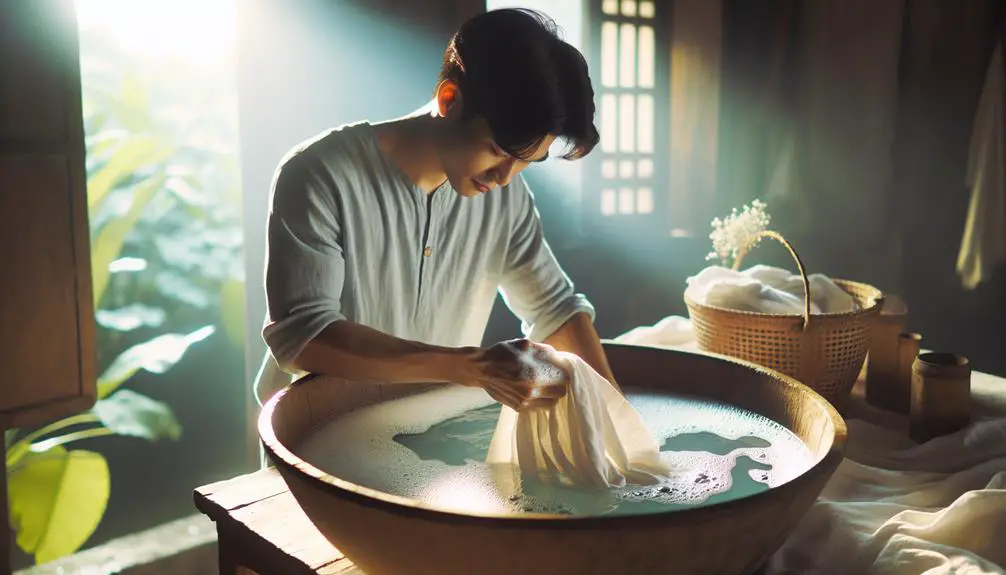I make sure to sort my linens by color before washing. Using a mild detergent keeps them soft and vibrant. For stains, eco-friendly options like lemon juice work wonders. Following care labels is key for longevity. Pre-washing helps prevent shrinkage. Air drying maintains their softness. Ironing with medium heat gives them a crisp finish. There's more to discover about natural stain removal, air drying benefits, and ironing tips to keep your linens looking their best.
Table of Contents
Key Takeaways
- Sort by color to prevent bleeding
- Use mild detergent for delicate fabrics
- Follow care labels for washing instructions
- Opt for gentle cycle setting
- Air dry to maintain softness
Sorting Linens by Color
When doing laundry, I always make sure to categorize my linens by color to prevent any mishaps during the washing process. Proper sorting is essential to avoid color bleeding, especially with dark colors. By separating white, dark, and colored linens into different loads, I guarantee that each item retains its vibrancy. Washing dark colors separately not only helps them maintain their rich hues but also contributes to the longevity and quality of the fabric.
Categorizing linens by color is a simple yet effective way to preserve the original appearance of your items. By following these guidelines, you can prevent unwanted color transfers and keep your linens looking fresh and vibrant for longer. Taking the time to categorize your linens before washing may seem like a small step, but it makes a significant difference in maintaining the quality of your fabric.
Using Gentle Detergent
To ensure the proper care of your linen items, choose a mild detergent specifically formulated for delicate fabrics. When washing linen, it is crucial to select a gentle detergent that will help preserve the natural colors and softness of this exquisite natural fabric. Harsh chemicals like bleach can harm the fibers and decrease the lifespan of your linen pieces. Instead, seek detergents with natural ingredients that offer a mild yet efficient clean.
Here is a useful table to assist you in choosing the appropriate detergent for your linen:
| Mild Detergent Features | Benefits |
|---|---|
| Specifically designed for delicate fabrics | Prevents harm to linen fibers |
| Soft on fabrics | Preserves natural colors and softness |
| Free from strong chemicals | Maintains fabric integrity and longevity |
| No optical brighteners | Prevents staining and harm |
Treating Stains Naturally
When it comes to treating stains on linen naturally, a few household items can work wonders.
Lemon is my go-to for tough stains, while the magic of baking soda and vinegar mixture can conquer even the most stubborn marks.
Plus, harness the power of sunlight for natural bleaching to revive your linen's pristine look.
Lemon for Tough Stains
Using the natural acidity of lemon juice can effectively tackle tough stains on linen. Lemon juice, with its citric acid properties, is a great eco-friendly stain remover. Simply apply lemon juice directly to the stubborn stain on your linen fabric and let it sit for a few minutes before washing. The citric acid works to break down and lift the stain from the linen fibers.
For enhanced results, expose the lemon-treated stain to sunlight before washing. This natural method is gentle on your linen and the environment, making it a fantastic alternative to harsh chemical stain removers. Embracing the power of lemon juice can help you maintain your linen looking clean and fresh without compromising on sustainability.
Baking Soda Magic
Let's now explore the natural stain-fighting prowess of baking soda for keeping your linen fresh and clean.
Baking soda, a gentle and natural stain remover, is perfect for treating stains on linen fabric. It works by absorbing and lifting stains effectively without the use of harsh chemicals.
For tougher stains, you can create a paste using baking soda and water, or combine it with vinegar for added cleaning power. This method is tough on stains but gentle on delicate linen fibers, ensuring your fabric remains in great condition.
Simply apply the baking soda paste to the stained area before washing to see the magic happen. Baking soda is a versatile and eco-friendly solution for maintaining your linen's pristine appearance.
Sunlight Bleaching Power
Harness the natural power of sunlight to effectively bleach and treat stains on your linen fabric. When it comes to brightening white linens and removing stains, direct sunlight is a game-changer. Here are some key points to keep in mind:
- Sunlight has natural bleaching power that can help remove stains from linen fabric.
- Sunlight can effectively lighten and brighten white linens without the use of harsh chemicals.
- Direct sunlight exposure can break down stains and odors in linen, leaving them fresh and clean.
- Hanging linen items in direct sunlight can help reduce discoloration and yellowing over time.
Embrace the sun's natural bleaching abilities to keep your linen looking fresh and pristine!
Following Care Instructions
When it comes to washing your linen items, the care labels are your best friends. Make sure to read them carefully to know the recommended water temperature and washing cycle.
Choosing a mild detergent and using a gentle cycle will help keep your linen pieces in top shape.
Read Care Labels
Reading care labels attentively before washing linen is vital to guarantee proper cleaning and maintenance of your items.
- Care labels provide specific instructions for water temperature, detergent type, and drying methods.
- Following care instructions prevents damage and maintains quality.
- Care labels may recommend hand washing or machine washing based on the linen product.
- Ignoring care labels can lead to shrinkage, color fading, or damage to delicate fabrics.
Checking care labels before washing helps prolong the lifespan of linen items, ensuring they look their best for longer. It's important to follow these guidelines to make sure your linens remain in top condition and last for years to come.
Choose Proper Detergent
When checking the care labels before washing your linen items, the next step is to select a mild detergent appropriate for delicate fabrics as indicated in the care instructions. It's essential to follow the guidelines on the garment tags to make sure you're using the right detergent type.
Harsh chemicals and bleaching agents can harm the natural fibers of linen, so opt for eco-friendly or natural detergents. By choosing the correct detergent based on care instructions, you can help prevent color fading and maintain the integrity of your linen pieces.
Use Gentle Cycle
To guarantee the proper care of your linen items, always follow the gentle cycle setting specified in the care instructions for washing.
When it comes to machine washing your linen fabric, using a gentle cycle is crucial to prevent damage to the fabric fibers. By adhering to the care instructions provided, you confirm the appropriate washing method is applied, maintaining the quality of the linen over time.
The gentle cycle not only safeguards the fabric but also helps in preserving its natural texture and minimizing the risk of shrinkage, stretching, or pilling. Remember, opting for a delicate or hand wash setting when in doubt shows your linen the extra care it deserves.
Pre-Washing to Prevent Shrinkage
Before delving into sewing or wearing your linen pieces, it's important to pre-wash them to prevent potential shrinkage issues down the line. Linen fibers have the tendency to shrink around 3-5% after the first wash, making pre-treating essential to avoid surprises later on.
When pre-washing, it's vital to use the same temperature and method you intend for future washes. High heat or hot water should be avoided during pre-washing to prevent excessive shrinkage. Additionally, pre-washing not only helps prevent shrinkage but also serves to soften the fabric and eliminate any residual chemicals or finishes that may be present.
Air Drying for Softness
To guarantee the softness and natural texture of linen, air drying is the ideal method. When you hang your linen to dry, you not only maintain its fabric quality but also prevent shrinkage. Here are some key points to take into account when air drying your linen:
- Hanging: Suspend your linen garments or linens to air dry to maintain their shape and prevent any potential shrinking.
- Quick Drying: Linen dries relatively quickly when hung up, making it a convenient option for preserving the fabric quality without the need for high heat.
- Avoid High Heat: By steering clear of high heat from tumble drying, you can prevent damage to the fibers and ensure the linen stays soft.
- Line Drying: Opt for line drying outdoors if possible, as it can add a fresh, natural scent to your linen while preserving its softness.
Ironing Linens for a Crisp Finish
Considering the benefits of a crisp finish when ironing linens, how can you achieve the desired results without compromising the fabric quality?
To start, iron your linen on a medium heat setting while it's slightly damp to avoid damaging the fibers.
When dealing with linen pants or dresses, remember to press the pockets to prevent any bulkiness.
For dark-colored linens, iron them on the wrong side to prevent potential fabric discoloration.
Utilize the steam setting on your iron, especially for dry linen fabrics, as it helps to ease out wrinkles effectively.
In case you have hard-to-iron garments, using a steamer can be a convenient alternative to traditional ironing methods.
Frequently Asked Questions
Can I Put Linen in the Washing Machine?
Yes, I can put linen in the washing machine. It's safe to wash linen in the machine, but I should separate colors, use a gentle cycle, and avoid overloading. Keeping heavy items out helps maintain the quality.
Can 100% Linen Be Washed?
Yes, 100% linen can be safely washed to maintain its quality. I recommend washing it in lukewarm water with a gentle detergent. Avoid bleach and harsh chemicals to preserve the fabric's integrity and longevity.
Can You Put Linen in Dryer?
I usually put linen in the dryer on low heat, but air drying is ideal to prevent shrinkage. Removing it slightly damp helps with wrinkles. Line drying maintains its texture. It's all about preserving that lovely linen feel!
How Do You Wash Linen so It Doesn't Shrink?
To wash linen so it doesn't shrink, I always opt for lukewarm water and a gentle cycle. I use mild detergent suitable for delicate fabrics, avoid overloading the machine, and separate colors. Air-drying promptly is key for maintaining shape.
- What Does Polyamide Fabric Feel Like? A Guide to Texture and Comfort - June 30, 2025
- Does Polyamide Pill? How to Keep Your Garments Smooth and Bobble-Free - June 30, 2025
- Is Polyamide See-Through? What to Know Before You Buy - June 30, 2025





